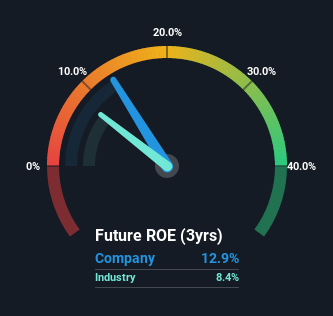One of the best investments we can make is in our own knowledge and skill set. With that in mind, this article will work through how we can use Return On Equity (ROE) to better understand a business. By way of learning-by-doing, we'll look at ROE to gain a better understanding of CGN New Energy Holdings Co., Ltd. (HKG:1811).
Return on equity or ROE is a key measure used to assess how efficiently a company's management is utilizing the company's capital. Put another way, it reveals the company's success at turning shareholder investments into profits.
Check out our latest analysis for CGN New Energy Holdings
How To Calculate Return On Equity?
 The formula for ROE is:
The formula for ROE is:
Return on Equity = Net Profit (from continuing operations) ÷ Shareholders' Equity
So, based on the above formula, the ROE for CGN New Energy Holdings is:
13% = US$197m ÷ US$1.5b (Based on the trailing twelve months to June 2022).
The 'return' is the profit over the last twelve months. That means that for every HK$1 worth of shareholders' equity, the company generated HK$0.13 in profit.
Does CGN New Energy Holdings Have A Good ROE?
By comparing a company's ROE with its industry average, we can get a quick measure of how good it is. However, this method is only useful as a rough check, because companies do differ quite a bit within the same industry classification. As you can see in the graphic below, CGN New Energy Holdings has a higher ROE than the average (8.4%) in the Renewable Energy industry.

SEHK:1811 Return on Equity September 19th 2022
That's clearly a positive. However, bear in mind that a high ROE doesn't necessarily indicate efficient profit generation. Aside from changes in net income, a high ROE can also be the outcome of high debt relative to equity, which indicates risk. You can see the 2 risks we have identified for CGN New Energy Holdings by visiting our risks dashboard for free on our platform here.
Why You Should Consider Debt When Looking At ROE
Virtually all companies need money to invest in the business, to grow profits. That cash can come from retained earnings, issuing new shares (equity), or debt. In the first two cases, the ROE will capture this use of capital to grow. In the latter case, the debt used for growth will improve returns, but won't affect the total equity. That will make the ROE look better than if no debt was used.
Combining CGN New Energy Holdings' Debt And Its 13% Return On Equity
It seems that CGN New Energy Holdings uses a huge volume of debt to fund the business, since it has an extremely high debt to equity ratio of 3.96. Its ROE is respectable, but it's not so impressive once you consider all of the debt.
Summary
Return on equity is a useful indicator of the ability of a business to generate profits and return them to shareholders. Companies that can achieve high returns on equity without too much debt are generally of good quality. If two companies have the same ROE, then I would generally prefer the one with less debt.
But when a business is high quality, the market often bids it up to a price that reflects this. The rate at which profits are likely to grow, relative to the expectations of profit growth reflected in the current price, must be considered, too. So I think it may be worth checking this free report on analyst forecasts for the company.
If you would prefer check out another company -- one with potentially superior financials -- then do not miss this free list of interesting companies, that have HIGH return on equity and low debt.
Have feedback on this article? Concerned about the content? Get in touch with us directly. Alternatively, email editorial-team (at) simplywallst.com.
This article by Simply Wall St is general in nature. We provide commentary based on historical data and analyst forecasts only using an unbiased methodology and our articles are not intended to be financial advice. It does not constitute a recommendation to buy or sell any stock, and does not take account of your objectives, or your financial situation. We aim to bring you long-term focused analysis driven by fundamental data. Note that our analysis may not factor in the latest price-sensitive company announcements or qualitative material. Simply Wall St has no position in any stocks mentioned.
我們能做的最好的投資之一就是我們自己的知識和技能。考慮到這一點,本文將討論如何使用股本回報率(ROE)來更好地瞭解企業。通過邊做邊學的方式,我們將看到淨資產收益率,以更好地瞭解中廣核新能源控股有限公司(HKG:1811)。
股本回報率(ROE)是用來評估公司管理層利用公司資本效率的關鍵指標。換句話説,它揭示了該公司成功地將股東投資轉化為利潤。
查看我們對中廣核新能源控股的最新分析
如何計算股本回報率?
 這個淨資產收益率公式是:
這個淨資產收益率公式是:
股本回報率=(持續經營的)淨利潤?股東權益
因此,根據上述公式,中廣核新能源控股的ROE為:
13%=1.97億美元×15億美元(基於截至2022年6月的12個月)。
“收益”是過去12個月的利潤。這意味着,每1港元的股東權益,該公司就會產生0.13港元的利潤。
中廣核新能源控股的淨資產收益率好嗎?
通過將一家公司的淨資產收益率(ROE)與其行業平均水平進行比較,我們可以快速衡量它有多好。然而,這種方法只是作為一種粗略的檢查,因為在同一行業分類中,公司確實有很大的不同。如下圖所示,中廣核新能源控股的淨資產收益率高於可再生能源行業的平均水平(8.4%)。

聯交所:1811年9月19日
這顯然是一個積極的因素。然而,請記住,高淨資產收益率並不一定意味着有效的利潤創造。除了淨利潤的變化外,高淨資產收益率也可能是高負債相對於股本的結果,這表明存在風險。您可以通過訪問我們的風險控制面板在我們的平臺上是免費的。
為什麼在考慮淨資產收益率時應該考慮債務
幾乎所有的公司都需要資金來投資於業務,以增加利潤。這些現金可以來自留存收益、發行新股(股權)或債務。在前兩種情況下,淨資產收益率將抓住這種資本增長的用途。在後一種情況下,用於增長的債務將提高回報,但不會影響總股本。這將使淨資產收益率看起來比不使用債務的情況下更好。
將中廣核新能源控股的債務和13%的股本回報率結合起來
中廣核新能源控股似乎使用了鉅額債務來為這項業務提供資金,因為它的債務與股本比率極高,為3.96。它的淨資產收益率是可觀的,但如果你考慮到所有的債務,就不會那麼令人印象深刻了。
摘要
股本回報率是衡量一家企業產生利潤並將其返還給股東的能力的有用指標。能夠在沒有太多債務的情況下實現高股本回報率的公司通常質量良好。如果兩家公司的淨資產收益率相同,那麼我通常會傾向於債務較少的那一家。
但當一項業務是高質量的時,市場往往會將其抬高到反映這一點的價格。相對於當前價格反映的利潤增長預期,也必須考慮利潤可能增長的速度。所以我覺得這可能值得一查免費分析師對該公司的預測報告。
如果你更願意看看另一家公司--一家財務狀況可能更好的公司--那麼不要錯過這一點免費列出了一些有趣的公司,這些公司擁有高股本回報率和低債務。
對這篇文章有什麼反饋嗎?擔心內容嗎? 保持聯繫直接與我們聯繫。或者,也可以給編輯組發電子郵件,地址是implywallst.com。
本文由Simply Wall St.撰寫,具有概括性。我們僅使用不偏不倚的方法提供基於歷史數據和分析師預測的評論,我們的文章並不打算作為財務建議。它不構成買賣任何股票的建議,也沒有考慮你的目標或你的財務狀況。我們的目標是為您帶來由基本面數據驅動的長期重點分析。請注意,我們的分析可能不會將最新的對價格敏感的公司公告或定性材料考慮在內。Simply Wall St.對上述任何一隻股票都沒有持倉。
 這個淨資產收益率公式是:
這個淨資產收益率公式是: 聯交所:1811年9月19日
聯交所:1811年9月19日
 The formula for ROE is:
The formula for ROE is: